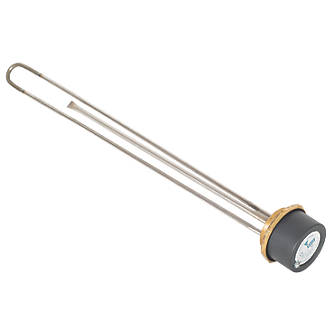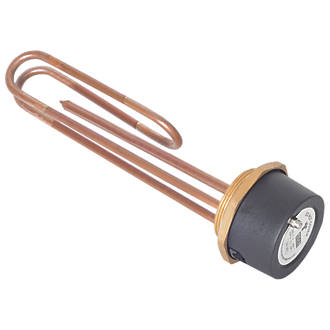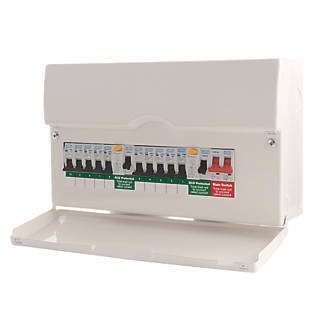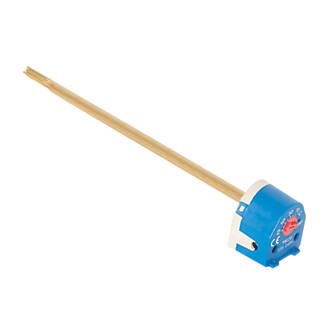Testing an immersion heater

This testing can be carried out by a more knowledgeable homeowner and advanced DIYers.
In this article, we advise customers who have the right tools and they are more confident in testing the immersion heaters with a multimeter. You can buy a multimeter on amazon or at the local merchants. This work involves electric testing.
Read on and we show you:
- What are the steps to check a heating element?
- What readings you should have.
- And what should you do if you find a fault?
An immersion heater typically consists of three key components: a heating element, a thermostat and an automatic cut-off device.
To diagnose a faulty immersion heater you have to carry out three testings:
Testing between the heating element terminals where you should read on the multimeter screen 20 ohms.
Testing between the two terminals on the immersion heaters thermostat (stat). Your reading has to be below 1 ohm when the water is cold.
Between the heating element and the casing you should have an open circuit (OL)
How the immersion heaters are used
Normally the cold water will enter the cylinder at the bottom. The hot water goes out to the top of your taps. The cold water will be supplied to a storage tank that is in the loft or will be fed directly from the mains.
It is very common to have two immersion heaters one at the bottom and one at the top.
The bottom immersion heater will be heated up at night at a cheap rate of electricity which heats the entire cylinder.
The top immersion heater will be used in the daytime, which will heat only the top part of the cylinder.
If your immersion heater is located right on the top of the cylinder, this will be a long one that will go down almost at the bottom.
Heating element

The immersion heater alloy coil is called a heating element this will be inside the cylinder.
Inside the heating element (which is made from alloy which is used in hard water areas), there is a coil of wire which heats up. The tube in the middle of the immersion heater is the thermostat which is controlling the temperature.
Before you start the work

Make sure you turn off the switch in the fuse box.
The immersion heater cover slides onto the threaded rod which holding the top cover in place, but it is also the earth connection. A green/yellow wiring will be attached to the bottom.
Wiring
There is also the Neutral connection. This neutral connection is going into one side of the heating element, the ~230 volts will be returning at this point.
The other side of the heating element is connected to the point marked with “T”. From here a small wire connected to the thermostat.
The incoming ~230-240 Volt goes to the left side of the thermostats, where the temperature will be controlled. From the thermostats, the other wire will be connected to the immersion heater heating element.
The thermostat is just a switch. When heat requires the two-terminal is linked together inside the thermostat. When the temperature will reach the desired settings the switch inside the thermostat will open and disconnect the terminals, the thermostat will turn off.
In the middle of the thermostat, you can find the temperature control button where you can set the temperature to at least 60° C. If any reason the temperature control will fail, the thermostats will be on continuously and overheats. Meaning ~230 volts will go through this two-terminal even when the thermostat is off.
To prevent the water from overheating up to 90° C (where the water will start to boil) the reset pin will pop out and disconnect the terminals in the thermostats. This means that the main immersion heater thermostat failed and you have to replace it.
If you can’t see the reset pin on the thermostat then it will be a separate one. Normally you will find the overheated device next to the thermostat. Then the power will be connected first to the overheat device and after to the heating element.
In simple English:
~230 volts will flow through the thermostat first, where the temperature will be set to 60° C at least. The power will flow through the overheat cut off-device and after connects to the heating element from the thermostat. The ~230 volts will go around the wire inside the heating element, heating your water and returns to the neutral connection.
How do you test the immersion heater element?
You need a multimeter and have to use it on OHM settings.
Check the multimeter proper function by connecting the lead. You have to see 0 (zero) or 00.1. This means the multimeter is working.
Testing the heating element
The heating element itself should have a really low resistance between the N (neutral) and the other side which is the “T”.
You have to check the wire in the heating element if it’s still in good condition. Meaning the wire inside is not broken.
Attach the red and black multimeter lead to the heating element. Remember you are still using OHM settings.
On a 3KW immersion heaters, the reading should be around 20 ohms. But anything between the 15-25 ohm is normal, meaning everything working properly.
If the reading is 1 or OL (open circuit), it means the wire inside the element is burned through.
If your readings are very high, the water probably gets inside your immersion heaters.
How to fix it:
You have to drain the water from the cylinder by opening the tap and draincock. After you need a special cylinder remover tool and take out the cylinder by turning it anticlockwise. If the cylinder is old it can crack and you have to fit a new cylinder.
If you struggling to do the work yourself, call our professional plumber who can do the work.
Testing the immersion heater thermostat

Remember that this is only a switch. The multimeter settings remain on ohm resistance. So you testing if the terminals are connecting or not together when you turn up the switch.
The thermostat (stat) will be a closed connection when ~230 volts flowing through on it, and an open connection when there are no ~230 volts going through between the two terminals.
Connect the leads to both sides of the stat. Doesn’t matter which leads connect where.
If your thermostats are turned to 60° C, there are ~230 volts flowing through the terminals.
The measurement you have to get on the multimeter display is 0 or 00.2.
If you turn the stat to a lower temperature, first you have to hear a click.
If the thermostat is of the reading on your multimeter should be 1 or OL (infinite resistance, open line).
If the thermostat is on 60° C and your readings are 1 or OL it means it failed.
How to fix:
Remove the wiring from the thermostat, buy a new one and replace it. The thermostats will slide out from the immersion heaters body.
Testing between the heating element and the immersion heater body
You still on ohm resistance settings on the multimeter.
Your readings should be 1 or OL. You should have high resistance, an open (OL) reading. This reading is totally fine.
The only problem you could have in this testing is that the multimeter applies only a small voltage (1.5-3volt). For a proper reading, you need an insulation tester that applies 500 volts which is expensive.
But if you find that you have done all the testing and the switch is still tripping in the fuse box, then there is a fault between the heating element and earth connection.
If you have done all the testing and everything was fine and your immersion heater is still not working the flat is elsewhere. You have to check the fuse the controls or wiring.
How to fix your faulty immersion heaters:
Change the immersion heater.
Frequently asked questions
Q: How do you test an immersion heater with a multimeter?
You need to buy a multimeter that you can pick up in the local plumbing merchants or from amazon.
Q: What is the required resistance of an immersion heater?
Anywhere between 15-20 ohms are good. OL or 1 means the immersion heater is faulty.
Q: How long should I have my immersion heater on?
For a 100-150 litre water tank, the immersion heater needs to be on from 1.5 to 3 hours. This is how long it takes for the immersion heater to heat your water.
Q: What happens if you leave the immersion heater on?
Nothing dangerous. The immersion heater will be on constantly, but the stat controlling the immersion heater. So if the desired temperature is reached the stat will switch off the immersion heater.
Q: Is it cheaper to leave the immersion on all the time?
No. To run an immersion heater is quite costly. If you are on holiday turn it off. If you also have a gas boiler that can be used instead to heat the water use the boiler. You can see on your meter how fast is spinning when you turn on your immersion heaters.
Q: Why do I have 2 immersion heaters?
The bottom one is used at night when the electricity is cheaper, the top one is used in the daytime when you need hot water.
Q: Is it cheaper to use a boiler or immersion heater?
Yes. Gas will be always cheaper than electricity.
Q: What is the ideal temperature for an immersion heater?
You need a minimum of 60C to kill any legionella that can grow in the cylinder.
Q: Do all hot water tanks have immersion heaters?
Most of them have an immersion heater in the UK, but this is used as a backup if your boiler breaks down.
Do you need a plumber for your immersion heater replacement?
If you feel that this is a quite big job for you, contact us today and we can book you an experienced plumber or gas engineer.
The post Testing an immersion heater appeared first on MML Plumbing Ltd.
from MML Plumbing Ltd https://ift.tt/3hwG3Qp
via IFTTT


No comments:
Post a Comment